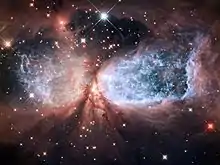Sh2-106
Sh2-106[2] is an emission nebula and a star formation region in the constellation Cygnus. It is a H II region estimated to be around 2,000 ly (600 pc) from Earth, in an isolated area of the Milky Way[2]
| Emission nebula | |
|---|---|
| H II region | |
 Sharpless 2-106 | |
| Observation data: J2000.0 epoch | |
| Subtype | bipolar nebula |
| Right ascension | 20h 27m 27.1s[1] |
| Declination | +37° 22′ 39″[1] |
| Distance | 2,000 ly (600 pc) |
| Apparent dimensions (V) | 3′ × 3′ |
| Constellation | Cygnus |
| Designations | S106 |
In the center of the nebula is a young and massive star that emits jets of hot gas from its poles, forming the bipolar structure. Dust surrounding the star is also ionized by the star. The nebula spans about 2 light-years across.[3]
Central star
The central star, a source of infrared radiation usually referred to as S106 IR or S106 IRS 4, is believed to have been formed only 100,000 years ago.[4] It is a massive star, approximately 15 solar masses. Two jets of matter streaming from its poles heat surrounding matter to a temperature of around 10,000 °C.[3] Dust that is not ionized by the star's jets reflect light from the star. With an estimated surface temperature of 37,000°K, it is classified as a type O8 star. It loses around 10−6 per year in solar winds, ejecting material at around 100 km/s.[5]
Studies of images has revealed that the star-forming region has also created hundreds of low-mass brown dwarf stars[4] and protostars.[6]
References
- "SH 2-106". SIMBAD Astronomical Database. Retrieved 2013-01-13.
- NASA, ESA, and the Hubble Heritage Team (STScI/AURA) (6 Dec 2011). "Hubble Serves Up a Holiday Snow Angel". Retrieved 13 Jan 2013.CS1 maint: multiple names: authors list (link)
- "Young star rebels against its parent cloud". 15 Dec 2011. Retrieved 13 Jan 2013.
- Nemiroff, R.; Bonnell, J., eds. (7 Nov 2011). "Star Forming Region S106". Astronomy Picture of the Day. NASA. Retrieved 13 Jan 2013.
- Bally, J.; Snell, R.L.; Predmore, R. (1 Sep 1983). "Radio images of the bipolar H II region S106". Astrophysical Journal, Part 1. 272: 154–162. Bibcode:1983ApJ...272..154B. doi:10.1086/161272. ISSN 0004-637X.
- Oasa, Yumiko; Tamura, Motohide; Nakajima, Yasushi; Itoh, Itoh; Maihara, Toshinori; Iwamuro, Fumihiko; Motohara, Kentaro; Saeko, S.; Hayashi, Masahiko; et al. (Mar 2006). "Very Low Luminosity Young Cluster and the Luminosity and Mass Functions in S106". The Astronomical Journal. 131 (3): 965–978. Bibcode:2006AJ....131.1608O. doi:10.1086/500086.